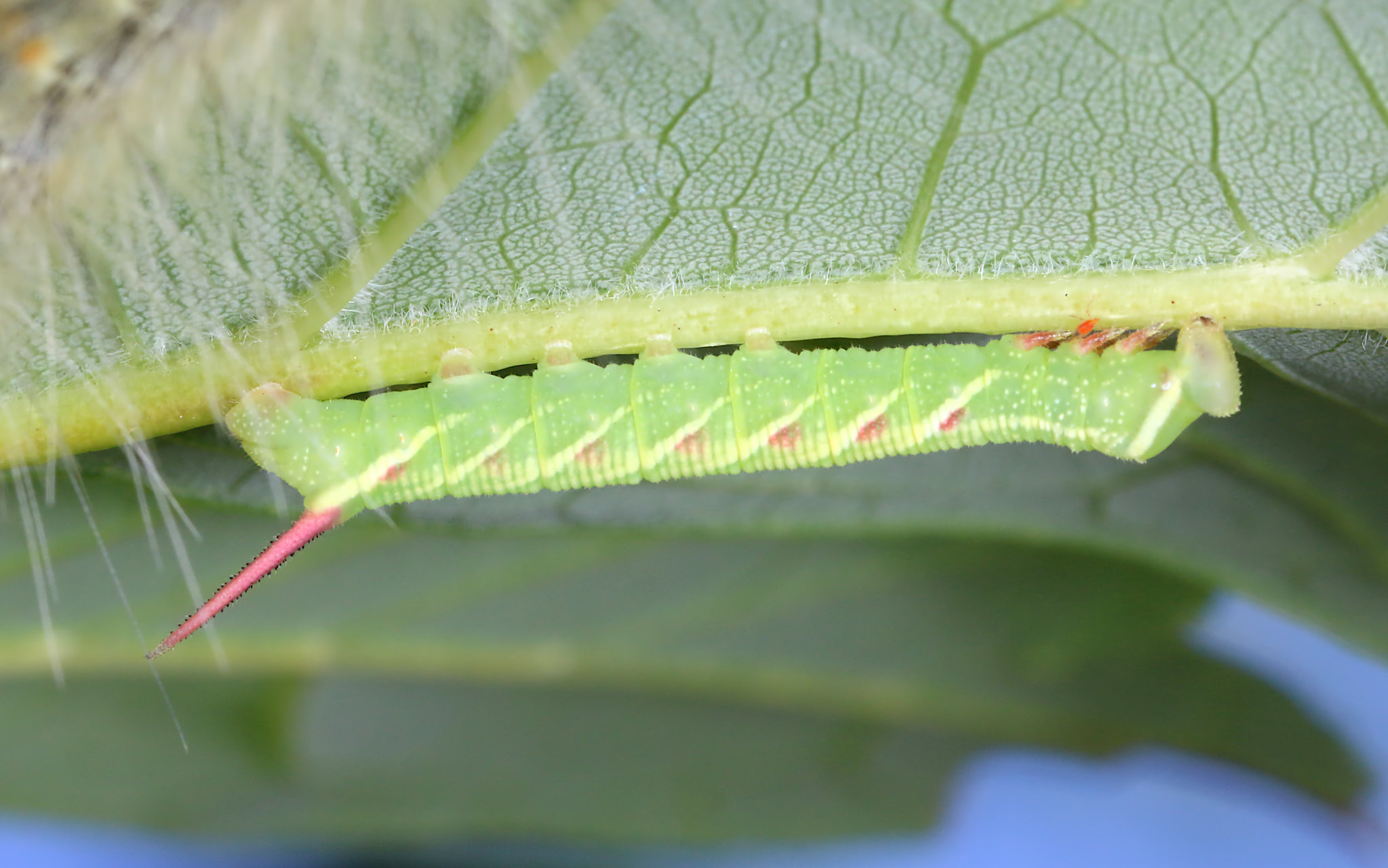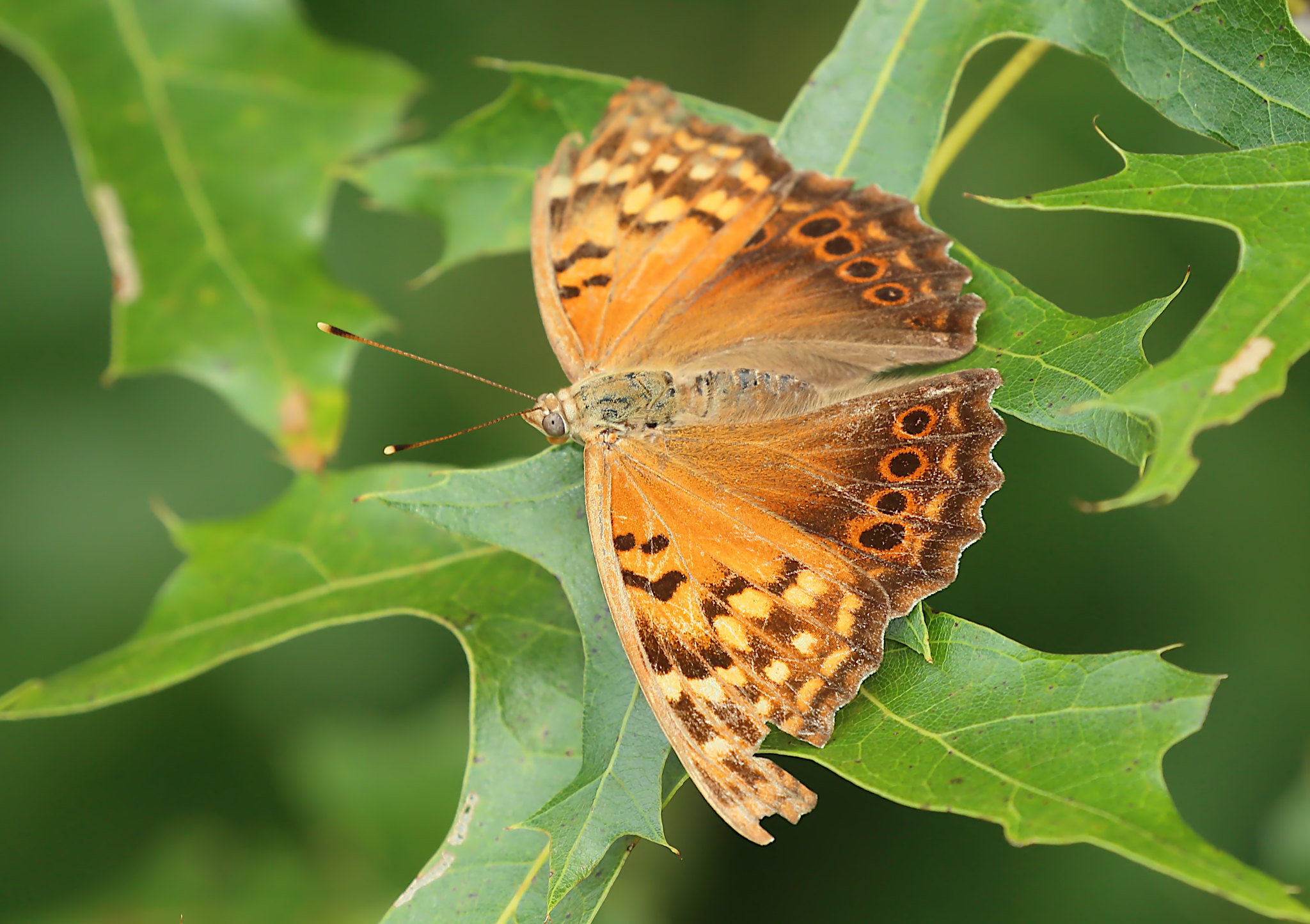Lets do some Leps!
Jul 4, 2020 08:21:27 #
Lepidoptera (butterflies and moths) that is. I just had a bunch in the cue of late summer pictures, and so decided to lump ‘em together.
First up is a super common late season caterpillar, the fall webworm (Hyphantria cunea). They are everywhere late in the summer, feeding on a wide range of host plants. Fall webworms are in the tiger moth family.
 Fall webworm by Mark Sturtevant, on Flickr
Fall webworm by Mark Sturtevant, on Flickr
On the same leaf as the webworm (you can see the hairy cat in the corner) was a little hornworm. This one gave me conniptions since I could not separate it from 3 possible species, even though the food plant was IDed as elm. But my personal team of Expert Lepidopterists at BugGuide had a meeting and concluded this is the larva of the waved sphinx moth (Ceratomia undolosa).
 Waved sphinx caterpillar by Mark Sturtevant, on Flickr
Waved sphinx caterpillar by Mark Sturtevant, on Flickr
Mourning cloak butterflies (Nymphalis antiopa) must be common, but I don’t see many of them. They are ‘different’ in that they prefer to perch up on trees for extended periods where they feed on sap. Not a great picture, but I was excited just to have a chance to photograph one since I seldom see them except for a few seconds as they zip past in a great hurry. They never stop to look at the pretty flowers.
 Mourning cloak butterfly by Mark Sturtevant, on Flickr
Mourning cloak butterfly by Mark Sturtevant, on Flickr
Next up is an extremely common species, though I find them hard to photograph because they are so damn alert. This of course is the painted lady (Vanessa cardui). Painted ladies are surely one of the most abundant butterflies in the world. Well known on almost every continent, and many populations migrate long distances in numbers so large that they are visible on radar. Heroic butterflies, painted ladies.
 Painted lady butterfly by Mark Sturtevant, on Flickr
Painted lady butterfly by Mark Sturtevant, on Flickr
Another extremely common butterfly is the hackberry emperor (Heterocampa celtis). I assumed that was what we have here, but while preparing this post I was pleasantly surprised to learn this is actually the tawny emperor (H. clyton). A small difference in the wing color pattern here and there and it’s a new species for me. One may wonder why a fairly drab butterfly is given the lofty name ‘emperor’. The answer seems to be because of the impressive head gear worn by the larvae in this group: https://bugguide.net/node/view/412017/bgimage
 Tawny emperor butterfly by Mark Sturtevant, on Flickr
Tawny emperor butterfly by Mark Sturtevant, on Flickr
 Tawny emperor butterfly by Mark Sturtevant, on Flickr
Tawny emperor butterfly by Mark Sturtevant, on Flickr
Moving back to caterpillars, next up is a single oakworm caterpillar, Anisota senatoria.
 Orange-tipped oakworm caterpillar by Mark Sturtevant, on Flickr
Orange-tipped oakworm caterpillar by Mark Sturtevant, on Flickr
Oakworms are actually miniature Saturniids, belonging to the same family as the giant silkworms (cecropia, atlas moths, etc.). Oakworms are more closely related to the monstrous hickory horned devil side of the family, and as such they have horns, not tubercles, and they pupate in the ground rather than spin cocoons. I said ‘single’ oakworm since the Magic Field has many pin oak trees, and these caterpillars become extremely numerous on them. A single tree could host dozens of oakworms, and there are at least hundreds of oak trees in the Magic Field.
Back in a different field (the same one with the fall webworm, come to think of it), the next picture shows what was a yellow-collared scape moth (Cisseps fulvicollis). As is often the case, finding a flower visiting insect that looks “wrong” is a good way to find an ambush predator on flowers. In this case it was possibly one of the running crab spiders.
 Crab spider and yellow-collared scape moth by Mark Sturtevant, on Flickr
Crab spider and yellow-collared scape moth by Mark Sturtevant, on Flickr
Finally, the gnarly looking inchworm below was doing its ‘nobody here but us twigs’ pose on the same plant. This is likely the larva of Anavitrinella pampinaria, or ‘common grey’. Once again BugGuide comes through in making me look like someone who really knows their caterpillars (no, I don’t). Since I recalled that the collared scape moth met its fate on a goldenrod, a simple search in BugGuide for ‘caterpillar on goldenrod’ yielded the probable ID in seconds.
 Inchworm caterpillar by Mark Sturtevant, on Flickr
Inchworm caterpillar by Mark Sturtevant, on Flickr
First up is a super common late season caterpillar, the fall webworm (Hyphantria cunea). They are everywhere late in the summer, feeding on a wide range of host plants. Fall webworms are in the tiger moth family.
 Fall webworm by Mark Sturtevant, on Flickr
Fall webworm by Mark Sturtevant, on FlickrOn the same leaf as the webworm (you can see the hairy cat in the corner) was a little hornworm. This one gave me conniptions since I could not separate it from 3 possible species, even though the food plant was IDed as elm. But my personal team of Expert Lepidopterists at BugGuide had a meeting and concluded this is the larva of the waved sphinx moth (Ceratomia undolosa).
 Waved sphinx caterpillar by Mark Sturtevant, on Flickr
Waved sphinx caterpillar by Mark Sturtevant, on FlickrMourning cloak butterflies (Nymphalis antiopa) must be common, but I don’t see many of them. They are ‘different’ in that they prefer to perch up on trees for extended periods where they feed on sap. Not a great picture, but I was excited just to have a chance to photograph one since I seldom see them except for a few seconds as they zip past in a great hurry. They never stop to look at the pretty flowers.
 Mourning cloak butterfly by Mark Sturtevant, on Flickr
Mourning cloak butterfly by Mark Sturtevant, on FlickrNext up is an extremely common species, though I find them hard to photograph because they are so damn alert. This of course is the painted lady (Vanessa cardui). Painted ladies are surely one of the most abundant butterflies in the world. Well known on almost every continent, and many populations migrate long distances in numbers so large that they are visible on radar. Heroic butterflies, painted ladies.
 Painted lady butterfly by Mark Sturtevant, on Flickr
Painted lady butterfly by Mark Sturtevant, on FlickrAnother extremely common butterfly is the hackberry emperor (Heterocampa celtis). I assumed that was what we have here, but while preparing this post I was pleasantly surprised to learn this is actually the tawny emperor (H. clyton). A small difference in the wing color pattern here and there and it’s a new species for me. One may wonder why a fairly drab butterfly is given the lofty name ‘emperor’. The answer seems to be because of the impressive head gear worn by the larvae in this group: https://bugguide.net/node/view/412017/bgimage
 Tawny emperor butterfly by Mark Sturtevant, on Flickr
Tawny emperor butterfly by Mark Sturtevant, on Flickr Tawny emperor butterfly by Mark Sturtevant, on Flickr
Tawny emperor butterfly by Mark Sturtevant, on FlickrMoving back to caterpillars, next up is a single oakworm caterpillar, Anisota senatoria.
 Orange-tipped oakworm caterpillar by Mark Sturtevant, on Flickr
Orange-tipped oakworm caterpillar by Mark Sturtevant, on FlickrOakworms are actually miniature Saturniids, belonging to the same family as the giant silkworms (cecropia, atlas moths, etc.). Oakworms are more closely related to the monstrous hickory horned devil side of the family, and as such they have horns, not tubercles, and they pupate in the ground rather than spin cocoons. I said ‘single’ oakworm since the Magic Field has many pin oak trees, and these caterpillars become extremely numerous on them. A single tree could host dozens of oakworms, and there are at least hundreds of oak trees in the Magic Field.
Back in a different field (the same one with the fall webworm, come to think of it), the next picture shows what was a yellow-collared scape moth (Cisseps fulvicollis). As is often the case, finding a flower visiting insect that looks “wrong” is a good way to find an ambush predator on flowers. In this case it was possibly one of the running crab spiders.
 Crab spider and yellow-collared scape moth by Mark Sturtevant, on Flickr
Crab spider and yellow-collared scape moth by Mark Sturtevant, on FlickrFinally, the gnarly looking inchworm below was doing its ‘nobody here but us twigs’ pose on the same plant. This is likely the larva of Anavitrinella pampinaria, or ‘common grey’. Once again BugGuide comes through in making me look like someone who really knows their caterpillars (no, I don’t). Since I recalled that the collared scape moth met its fate on a goldenrod, a simple search in BugGuide for ‘caterpillar on goldenrod’ yielded the probable ID in seconds.
 Inchworm caterpillar by Mark Sturtevant, on Flickr
Inchworm caterpillar by Mark Sturtevant, on FlickrJul 4, 2020 10:22:39 #
Mark Sturtevant wrote:
Lepidoptera (butterflies and moths) that is. I jus... (show quote)
Very nice series of some common leps.
There is a book for caterpillar ID. You use Bugguide, but someone else may want one. "Peterson First Guides". Caterpillars".
120 species, includes food plant and habits. My copy has 'faded' colors on the adults, not as bright as fresh specimens.
Many of the moths are attracted to black, and very bright lights. Porch lights and the like.
Thanks, Mark. Always interesting.
Bill
Jul 4, 2020 10:55:21 #
Jul 4, 2020 12:50:39 #
A wonderful collection of leps, you are very patient to 'sit' on them for so long. I would want to show them off straight away. The Painted Lady image is my favourite in terms of colour and composition, it is simply beautiful. So, I learned a new word today, conniptions 

Jul 4, 2020 15:09:30 #
EnglishBrenda wrote:
So, I learned a new word today, conniptions 

Thank you. It may be an American idiom. Some of course are even regional.
Jul 5, 2020 10:40:47 #
Jul 5, 2020 11:01:50 #
Very nice set and education. That last one looks like he was really happy to see you.
Jul 5, 2020 12:43:19 #
Mark, your work is as stunning as the narratives are highly educational. I am always visually delighted and learn something new each time I read your posts.
If you want to reply, then register here. Registration is free and your account is created instantly, so you can post right away.







